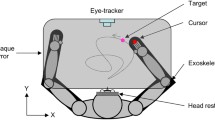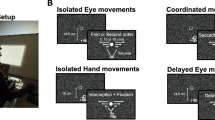Summary
In this study, a visual target was localized by both limb and eye. The experimental procedure provided an opportunity to analyze the limb movement trajectories to the target whose location was displaced during saccades. Absence of visual information about position of the moving limb did not interfere with correction of the trajectory of pointing movements. These corrections reflect the new information about target position that becomes available at the end of the first saccade. Mean localization errors to stationary and to displaced targets were not significantly different. This result suggests that subjects were able to compare visual (retinal + eye position) information about the position of the target with information about the position of their moving limb derived from kinesthesis and/or efference copies of the motor commands. An analysis of velocity profiles indicates that the observed corrections of hand movement to target displacement could not be identified by an inflexion point in the trajectory. None of the subjects reported seeing the target change location. In other words, the motor command was adjustable despite the failure of changes in visual locus to reach consciousness.
Similar content being viewed by others
References
Abrams RA, Kornblum S, Meyer DE (1983) Fitts' law: optimization of initial ballistic impulses for aimed movements. Bull Psychonom Soc 22: 335
Anderson TW (1958) An introduction to multivariate statistical analysis. Wiley, New York, 102–109, pp 48–49
Becker W, Fuchs AF (1969) Further properties of the human saccadic system: eye movements and correction saccades with and without visual fixation points. Vision Res 19: 1247–1258
Becker W, Jürgens R (1979) An analysis of the saccadic system by means of double step stimuli. Vision Res 19: 967–983
Bridgeman B, Lewis S, Heit G, Nagle M (1979) Relation between cognitive and motor-oriented systems of visual position perception. J Exp Psychol 5: 692–700
Biguer B, Jeannerod M, Prablanc C (1982) The coordination of eye, head and arm movements during reaching at a single visual target. Exp Brain Res 46: 301–304
Brooks BA, Fuchs AF (1975) Influence of stimulus parameters on visual sensitivity during saccadic eye movement. Vision Res 15: 1389–1398
Campbell FW, Wurtz RH (1978) Saccadic omission: why we do not see a grey-out during a saccadic eye movement. Vision Res 18: 1297–1303
Carlton LG (1981) Processing visual feedback information for movement control. J Exp Psychol 7: 1019–1030
Crossman ERFW, Goodeve PJ (1963) Feedback control of hand movement and Fitts' law. Published (1983) Q J Exp Psychol 35A: 251–278
Dodge R (1900) Visual perception during eye movement. Psychol Rev 7: 454–465
Fisk JD and Goodale MA (1985) The organization of eye and limbs movements during unrestricted reaching to targets in controlateral and ipsilateral visual space. Exp Brain Res 60: 159–178
Fitts PM (1954) The information capacity of the human motor system in controlling the amplitude of movement. J Exp Psychol 47: 381–391
Georgopoulos AP, Kalaska JF, Massey JT (1981) Spatial trajectories and reaction times of aimed movements: effects of practice, uncertainty and change in target location. J Neurophysiol 46: 725–743
Gielen CCAM, Van der Heuvel PJM, Van Gisbergen JAM (1984) Coordination of fast eye and arm movements in a tracking task. Exp Brain Res 56: 154–161
Hallett PE, Lightstone AD (1976a) Saccadic eye movements towards stimuli triggered by prior saccades. Vision Res 16: 99–106
Hallett PE, Lightstone AD (1976b) Saccadic eye movements to flashed targets. Vision Res 16: 107–114
Henson DB (1978) Corrective saccades: effects of altering visual feedback. Vision Res 18: 63–67
Keele SW, Posner MI (1968) Processing visual feedback in rapid movements. J Exp Psychol 77: 155–158
Lennie P, Sidwell A (1978) Saccadic eye movements and visual stability. Nature 275: 766–768
MacKay DM (1970) Elevation of visual threshold by displacement of retinal image. Nature 225: 90–92
MacLaughlin S (1967) Parametric adjustment in saccadic eye movements. Percept Psychophys 2: 359–362
Mather JA, Fisk JD (1985) Orienting to targets by looking and pointing. I. Parallels and interactions in ocular and manual performance. Q J Exp Psychol 37A: 315–338
Matin L (1982) Visual localization and eye movements. In: Wertheim AH, Wagenaar AW, Leibowitz HW (eds) Tutorials on motion perception. Plenum Press, New York, pp 101–156
Megaw ED (1974) Possible modification to a rapid on-going programmed manual response. Brain Res 71: 425–441
Paillard J (1982) The contribution of peripheral and central vision to visually guided reaching. In: Ingle GL, Goodale MA, Mensfield RJW (eds) Analysis of visual behavior. The MIT Press, Cambridge
Prablanc C, Jeannerod M (1974) Corrective saccades: dependance on retinal reafferent signal. Vision Res 15: 465–469
Prablanc C, Pélisson D, Goodale MA (1986) Visual control of reaching movements without vision of the limb. I. Role of retinal feedback of target position in guiding the hand. Exp Brain Res 62: 293–302
Soechting JF, Lacquaniti F (1983) Modification of trajectory of a pointing movement in response to a change in target location. J Neurophysiol 49: 548–564
Stark L, Bridgeman B (1983) Role of corollary discharge in space constancy. Percept Psychophys 34: 371–380
Täumer R (1975) Three reaction mechanisms of the saccadic system in response to a double jump. In: Basic mechanisms of ocular motility and clinical implications. Lennerstrand & Bach-Y-Rita, pp 515–518
Volkmann FC, Riggs LA, Moore RK, White KD (1978) Central and peripheral determinants of saccadic suppression. In: Senders JM, Fisher DF, Monty RA (eds) Eye movements and the higher psychological functions. Hillsdale, New York
Wheless LJ, Boynton R, Cohen G (1966) Eye-movement responses to step and pulse step stimuli. J Opt Soc Am 56: 956–960
Woodworth RS (1899) The accuracy of voluntary movement. Psychol Rev Monogr Suppl 3
Author information
Authors and Affiliations
Rights and permissions
About this article
Cite this article
Pélisson, D., Prablanc, C., Goodale, M.A. et al. Visual control of reaching movements without vision of the limb. Exp Brain Res 62, 303–311 (1986). https://doi.org/10.1007/BF00238849
Received:
Accepted:
Issue Date:
DOI: https://doi.org/10.1007/BF00238849




